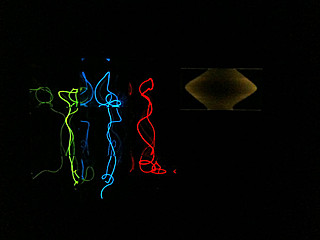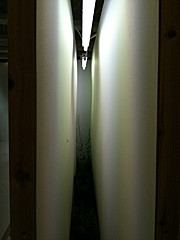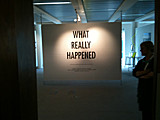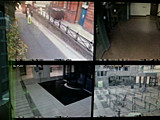
As is abundantly evident, its mid-to-late degree-show season. When caught in the middle, it sometimes seems like this time of year is a fairly directionless panic of sleepless nights, over-wrought angst, and a slightly overwhelming feeling that EVERYONE is graduating from a creative course somewhere, and EVERYONE has that great job (or more likely open-ended placement) lined up ahead of you. There is an increasing pressure on graduates (I think, based entirely on unscientific observational non-research) to be the ‘next big thing’, (partly fuelled by the star-tist and star-chitect culture of the nineties, partly by the increasing commercialisation of higher education and student debts…), and to somehow know exactly what they want to do amid the feedback-fuzz of a design-will-eat-itself* magpie culture.

I sometimes need to remind myself to pause for breath, and at the end of last week I had a chance to go to the ECA degree show and see what was happening there. The show was, overall, (and at risk of a massive blunt generalisation), quite good. But rather than try to review something so diverse and eclectic, I thought it might be useful to think about the context in which scottish (design) students are graduating.
Aside from the willingness with which most graduating students accept the de-facto format of ‘degree show’, it surprises me that every year at degree show time, the generalisations that people seem to make about the types of courses offered by art and design institutions get writ large in a strange dividing up of ‘typography’ from ‘ideas’, or ‘concepts’ from ‘craft.’ This chat can become a bit depressing, bar the fact that its hopefully only a few people indulging in it, but it does highlight one particular tension, about ‘what industry wants’, (as some of those in ‘industry’ have a habit of phrasing it).
Of course education and industry (in the broadest sense) should be in close contact and part of a dialogue (also including other external patrons and users of design who are not ‘businesses’) which is mutually beneficial, but the idea that Art Schools and Design Courses would be better off shaping their courses solely to the needs of business would be a massive error, and indicative of a think-big-but-ignore-the-detail type of strategic initiative for which governments, skill-councils and other quango’s are renowned.

Scotland is a small nation, with even smaller art and design courses, and the fact that there is some diversity in the types of course on offer is a massive bonus, and one that students can take advantage of. We are also in the massively beneficial position of being able to offer cohort sizes and staff/student ratios that would make a London student weep with envy. But we need to beware that we’re possibly at the thin end of a very thick wedge (given the recent budget) and its not going to be easy for small specialist institutions to stay small or specialist in the future. It strikes me as strange that when mergers are discussed for Scotland’s remaining independent art schools, its always with the nearest big university and never with each other.


The sinisterly titled D&AD ‘New Blood‘ show, part of the (surely ironicly titled) ‘free-range‘ graduate event (battery farm or zero-grazing anyone?) is a very visual demonstration of just how many creative graduates leave UK courses every year, and how highly many graduates from Scottish courses feature amongst them**, surely an affirmation of the scale and types of courses we can (currently) manage to run. These events (at their worst) are also indicative of the direction art and design education could head if we follow the idea that design courses should be focussed solely on churning out industry-ready and compliant machines. At risk of making a massive historical generalisation, the supposed glory-days of British graphic design, from Fletcher through to Brody and Saville et al. came on the back of a fairly archaic and/or anarchic art-school style education. That we have such strong small courses with their own characteristics, is something to build on, not something to ‘iron-out’.


So the ECA show, (particularly Graphic Design and Illustration as that’s where I spent most time), for me demonstrated (in the same way that GSA, DoJ, Grays and some of the other Scottish university degree courses do) a reassuring view of the design landscape in this north-west corner of Europe. The things that excited me most were the projects (like this CCTV one, by Piotr Klarowski) where students had challenged the visual protocol, tried to find a new angle into a topic, and allowed their time at university (and the freedoms afforded) to produce ideas that might not currently sit very comfortably in the grafik (sic) mainstream. But that’s a reflection of my personal tastes and interests, and, (while I’m convinced it’s those students that will make the most interesting designers, advertisers, filmmakers, artists and so on), I’m equally glad of the students who have produced more mainstream and archetypal work, but executed it with a depth and rigour, as it suggests a course (and design community?) where people with these interests and ideas can feed off each other, challenge each other, and the binary thinking that lurks around the corner can be held at bay for another year.

[I've used some shots of the eca show to illustrate this post, and tried to credit them below — any errors I apologise for, and please let me know, so they can be corrected].
Images, in order of appearance:
Signage
Recycling Centre outside Main Building
Main Hall, Textiles Product Design and Others
Val McLean, Intermedia Art
Stefania Strouza, Art Space and Nature MFA
Graphic Design Entrance
Piotr Klarowski, Graphic Design, CCTV Project
Assorted Business Cards
*Thanks to DC and KD for the lend of this turn of phrase.
**Though we’d do better to look at the international context rather than the national and work out whether we’re any good or not.














Comments